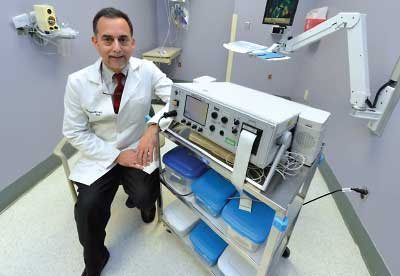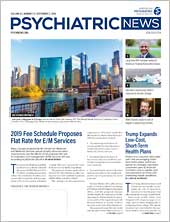Suicidal, depressed adults with insomnia who took fluoxetine alone or in combination with either blinded zolpidem or placebo in a randomized, controlled clinical trial slept better and experienced less depression and hopelessness, fewer nightmares, and better quality of life at the end of the eight-week study than at the outset.
Investigators reported results from their multisite study, Reducing Suicidal Ideation Through Insomnia Treatment (REST-IT), at the annual meeting of the American Academy of Sleep Medicine and the Sleep Research Society in Baltimore earlier this summer.
REST-IT, funded by the National Institute of Mental Health, is the first study to explore whether treating patients with depression, insomnia, and suicidal ideation with both an antidepressant and a hypnotic medication decreases intensity of suicidal ideation.
Two prior pilot studies found that treating patients with depression and insomnia with both fluoxetine and a hypnotic led to a higher rate of resolution of depression than fluoxetine alone. Suicidal patients were excluded from those studies.
While REST-IT study findings provided only a weak signal that zolpidem controlled release (CR) reduced suicidal ideation more than an SSRI alone, “I wouldn’t call it a negative study,” said W. Vaughn McCall, M.D., REST-IT’s principal investigator. McCall is the chair of the Department of Psychiatry and Health Behavior and executive vice dean at the Medical College of Georgia at Augusta University.
All patients had active suicidal ideation at baseline with no statistically significant differences between groups. Based upon preliminary analyses, McCall said, the zolpidem CR group had a marginally significant advantage during treatment on the Columbia Suicide Severity Rating Scale (C-SSRS) at p=0.057.
Among patients using zolpidem CR, sleep improved, and depression did not worsen. A different hypnotic, one with a longer half-life, may have shown greater benefit, McCall posited. The investigators originally had planned to use eszopiclone as the hypnotic. Because it was available as brand-name only at the time, McCall said, the NIMH asked the investigators to substitute a similar medication. They chose zolpidem CR.
More than 60 epidemiologic studies suggest insomnia predicts suicidal ideation and suicide death, McCall noted. The REST-IT study’s findings, he said, show it’s possible to conduct a double-blind, randomized, controlled trial of insomnia therapies and possibly other treatments in actively suicidal patients.
“While safety concerns usually prompt exclusion of people with suicidal ideation from randomized clinical trials, psychiatrists have an obligation to conduct such research,” McCall told Psychiatric News. “We need generalizable results for this population,” he said.
Researchers sought to include patients who had clinically relevant suicidal ideation (had thought of suicide but had no specific intent or plan to end their lives) and were not so ill they needed hospitalization, said REST-IT co-investigator Andrew Krystal, M.D., a professor of psychiatry and behavioral science at the University of California San Francisco School of Medicine.
The study’s safety features, Krystal said, follow the 2001 National Institutes of Health guidelines for intervention research with people at high risk of suicide.
Patients had to forgo psychotropic medications for seven days before baseline evaluations. Researchers assessed patients at baseline and over the study with self-report and clinician-rating tools, including the C-SSRS and Beck Scale for Suicide Ideation. Researchers encouraged patients to bring significant others to the first visit and to involve them in the study, Krystal said.
The study enrolled 103 adult outpatients (64 women, 39 men) aged 18 to 65 years who met criteria for major depressive disorder complicated by insomnia and suicidal ideation. All patients received open-label fluoxetine, 20 mg/day. This dose could be increased to 40 mg/day at the end of four weeks if the patient’s score on the Hamilton Rating Scale for Depression-24 was 15 or higher. The 5 percent of patients who could not take fluoxetine received a different SSRI (sertraline, 50 mg/day; paroxetine, 20 mg/day; or citalopram, 20 mg/day).
In addition to taking the SSRI, all patients were randomized to receive either blinded zolpidem CR, 6.25 mg/day, or blinded placebo for eight weeks. The dose could be increased to 12.5 mg/day at the end of week 1 if a patient had experienced little or no improvement in insomnia symptoms and had no side effects.
Participants were asked to wear wrist activity monitors, or actigraphs, throughout the eight-week treatment to record their sleep/wake patterns. They were seen in clinic visits at 1, 2, 4, 6, and 8 weeks post-randomization. To minimize overdose risk, researchers provided only enough of the study drugs at each visit to last until the next scheduled visit, plus an extra three days’ dose.
The researchers routinely called the participants midway between scheduled visits. “The calls might be seen as potentially having a placebo effect,” Krystal said, “but these were sick people.”
As soon as patients entered the study, investigators talked with them about plans for care after the study’s end. At that point, they gave patients enough SSRI medication to last until their first follow-up visit and checked in weekly by phone for two weeks to confirm patients were in treatment.
Of the 103 enrollees, 82 completed the study, McCall reported. None of the participants made suicide attempts or needed hospitalization.
REST-IT study findings still are being analyzed, McCall said. Further research is needed, he said, to clarify the relationship between insomnia and suicidal risk and to determine whether other treatments for insomnia, or for factors that may contribute to insomnia such as hyperarousal, can reduce that risk.
The study was conducted at the Medical College of Georgia at Augusta University and medical schools of Duke University, Wake Forest University, and the University of Wisconsin-Madison. ■
More information on the trial can be accessed
here.

